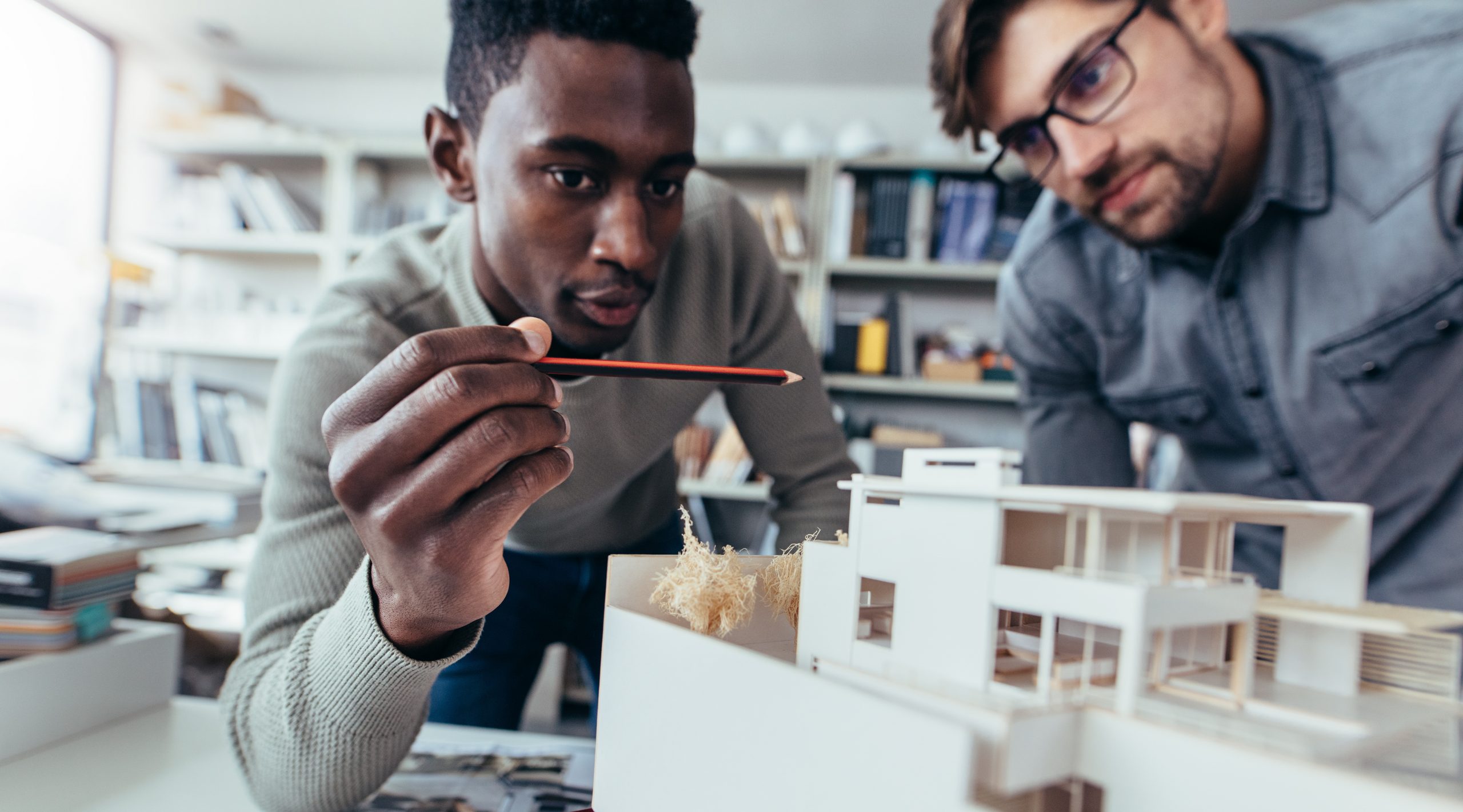Architect Interview Questions You Should Be Ready to Answer
Architect Interview Questions You Should Be Ready to Answer
Blog Article
Recognizing the Diverse Occupation Paths Available for Aspiring Architect
As an ambitious Architect, you have a world of career courses waiting for you. Whether you're drawn to conventional architecture or the nuances of sustainable layout, there's a niche that straightens with your rate of interests.
Typical Design: Designing Buildings and Structures
Standard architecture concentrates on designing buildings and structures that blend functionality with aesthetic allure. As you discover this area, you'll value the elaborate balance between form and function. You'll discover to attract motivation from historic styles, including aspects like balance, products, and workmanship. Your styles can show cultural heritage, showcasing local practices while fulfilling contemporary demands.
You'll develop skills in drafting, model-making, and website analysis, enabling you to picture and interact your ideas properly. Engaging with clients, you'll require to understand their vision and convert it right into feasible designs.
Moreover, constructing codes and sustainability practices are essential in your job, guaranteeing your structures are ecologically friendly and secure. As you expand in your profession, you'll discover chances in domestic, business, or perhaps reconstruction projects, each offering unique challenges. Welcoming traditional architecture paves the method for a satisfying career that pays tribute to the past while forming the future.
Urban Planning: Forming Areas and Public Spaces
As a hopeful Architect, you can play an important duty as a city planner, changing just how areas connect and operate. By utilizing community interaction approaches, you'll ensure that citizens have a voice in shaping their environment. Plus, incorporating sustainable design principles will help produce spaces that not just fulfill today's requirements however additionally secure the future.
Duty of Urban Planners
While many may think of designers as the single enthusiasts behind structures, city organizers play an essential function in forming the wider landscape of neighborhoods and public rooms. By teaming up with different stakeholders, you'll help develop parks, transportation systems, and property areas that advertise social communication and availability. Your experience in spatial layout and community characteristics allows you to picture future growth while maintaining cultural heritage.
Area Involvement Techniques
Effective area engagement approaches are crucial for urban organizers to guarantee that the voices of homeowners are listened to and valued in the planning process. To promote purposeful discussion, you must prioritize open forums and workshops where area participants can reveal their ideas and issues. Usage studies and social media to get to a wider audience, guaranteeing diverse perspectives are consisted of. Teaming up with neighborhood companies can enhance trust and promote deeper connections. It is essential to offer clear information regarding suggested projects and decision-making procedures, allowing citizens to feel enlightened and encouraged. By proactively incorporating and paying attention feedback, you'll produce rooms that mirror the area's needs, ultimately causing even more lasting and effective city environments. Embrace openness and constant discussion for long lasting impact.
Lasting Style Concepts
When designing city spaces, including sustainable design principles is important for producing environments that thrive both environmentally and socially. Take into consideration integrating eco-friendly spaces, like parks and gardens, to enhance biodiversity and boost air high quality.
Creating with water preservation in mind is also vital-- consider rain yards and absorptive surfaces to manage stormwater. Including community participants during the preparation procedure warranties that the areas you produce meet their needs and motivate social communication. By accepting these principles, you'll add to vivid, lasting metropolitan landscapes that profit everyone.

Landscape Style: Developing Lasting Outdoor Atmospheres
As you check out landscape architecture, you'll discover essential design concepts that develop stunning and practical exterior rooms. Lasting practices play an important function in making sure these environments prosper while reducing environmental impact. Plus, you'll discover a variety of occupation chances that enable you to make a real distinction in how people interact with nature.
Style Principles in Landscape
Recognizing style principles in landscape architecture is important for creating sustainable exterior atmospheres that harmonize with nature. You'll need to contemplate elements like percentage, scale, and balance to ensure your designs really feel cohesive and welcoming. Additionally, pay interest to seasonal changes, creating with products that enhance the environments year-round.
Lasting Practices Review
Sustainable methods in landscape style not only concentrate on appearances yet also focus on eco-friendly health and resource conservation. By incorporating indigenous plants, you boost biodiversity and reduce the need for chemical fertilizers and pesticides. Applying reliable watering systems helps conserve water and minimizes runoff, shielding neighboring ecosystems. You can make spaces that promote soil wellness, such as using natural materials and practicing permaculture concepts. Furthermore, incorporating eco-friendly framework, like rain gardens and porous pavements, help in stormwater management and decreases urban warmth. When you create outdoor environments with sustainability in mind, you add to a much healthier planet and offer rooms that cultivate neighborhood connection. Ultimately, these techniques the original source ensure your layouts profit both people and the setting for years to come.
Profession Opportunities Expedition
With a solid foundation in lasting methods, landscape architecture offers a variety of occupation paths that allow you to make a purposeful effect on the atmosphere. Urban coordinators commonly team up with landscape engineers to produce environment-friendly areas in city settings, enhancing city livability. If you're enthusiastic concerning education and learning, think about becoming a landscape style educator, inspiring future generations.
Sustainable Design: Concentrating On Eco-Friendly Practices
As you explore your career in style, accepting environment-friendly practices can establish you apart in a competitive area. Lasting design concentrates on developing structures that reduce ecological influence while boosting owner well-being. By integrating eco-friendly materials, energy-efficient systems, and sustainable building strategies, you'll add to a greener future.
Start by acquiring expertise of green certifications like LEED or BREEAM, which can bolster your credentials. Think about just how all-natural light, ventilation, and thermal effectiveness can enhance style. Collaborate with designers and environmental experts to innovate services that decrease waste and conserve resources.
Do not fail to remember the importance of area involvement-- engaging regional stakeholders can motivate styles that balance with the setting. As customers progressively prioritize sustainability, your competence in environmentally friendly methods will certainly not only bring in tasks but likewise accomplish your passion for responsible architecture. Accept this critical aspect of the profession, and view your job thrive.
Historic Conservation: Shielding and Recovering Social Heritage
While you start on your building journey, consider the necessary role of historic preservation in maintaining our social heritage. This area concentrates on the protection and reconstruction of significant structures, sites, and frameworks that tell the stories of our past. By engaging in historical preservation, you'll assist secure the building legacy that shapes neighborhood identity.
As a historical preservation Architect, you'll analyze historical relevance and analyze the problem check over here of structures. You'll function carefully with chroniclers and preservationists to assure genuine remediation techniques are used. This profession course allows you to blend creative thinking with research, allowing you to develop options that respect initial materials and craftsmanship.
Your job not only adds to sustainability by reusing existing structures but likewise promotes a feeling of pride within communities. Accepting this course will help you end up being a guardian of history, preserving the stories and aesthetic appeals that improve our lives.
Inside Architecture: Enhancing Indoor Spaces
Historic preservation and interior style both share a commitment to improving the developed environment, however they concentrate on various aspects. While historic conservation stresses maintaining a structure's historical and social value, indoor architecture zeroes in on optimizing interior rooms for functionality and aesthetics.
As a hopeful Architect, you'll discover that indoor architecture permits you to blend creative thinking with technical abilities. You'll design rooms that not only look excellent yet likewise promote comfort and effectiveness. This area includes comprehending just how light, color, and materials interact within a space, impacting mood and functionality.
You'll work on various tasks, from household homes to business workplaces, ensuring that each setting fulfills the needs of its occupants. By focusing on customer experience, you can transform insides into practical and inspiring areas, making a substantial effect on how individuals communicate with their surroundings. Accept the chance to boost indoor settings and shape the method people work and live.
Industrial Layout: Merging Performance With Visual Appeals
Commercial design plays a crucial role in creating items that perfectly mix looks with functionality, guaranteeing that what you use everyday is not only visually appealing but likewise functional. As an ambitious Architect, you might engage yourself in this area, concentrating on making whatever from furniture to consumer electronics. Your job includes comprehending customer needs, materials, and making processes, permitting you to develop ingenious services that boost day-to-day experiences.
In industrial design, you'll typically collaborate with marketing professionals, engineers, and manufacturers, making certain that your layouts are not just lovely yet also possible. You'll learn to stabilize type and function, focusing on usability without compromising design. By sharpening your abilities in laying out, 3D modeling, and prototyping, you'll be well-equipped to bring your concepts to life. This occupation course offers a vibrant environment where imagination meets practicality, making it a fulfilling selection for designers curious about forming the products of tomorrow.
Frequently Asked Questions
What Educational Credentials Do I Need to Come To Be a Designer?
To end up being an engineer, you'll need an expert level in architecture, normally a Bachelor's or Master's. Additionally, you'll need to complete a teaching fellowship and pass the Architect Registration Evaluation to practice legally.
Are There Qualification Needs for Various Building Profession Paths?
Yes, there're certification requirements for various building paths. Architect. You'll need to pass tests, complete teaching fellowships, and occasionally pursue specialized training, relying on your selected emphasis, like landscape style, metropolitan style, or historical conservation
What Software Application Skills Are Important for Designers Today?

Exactly How Can I Gain Practical Experience While Studying Style?
You can gain useful experience by interning at building firms, taking part in design competitors, volunteering for community jobs, or teaming up with classmates on real-world jobs. These possibilities improve your skills and build useful connections in the sector.
What Task Opportunities Exist Outside Conventional Style Firms?
You can explore numerous job chances outside standard design companies, like urban planning, interior design, landscape style, building and construction management, realty advancement, and even duties in sustainability consulting. Each offers unique challenges and rewards.
Whether you're attracted to conventional style or the subtleties of sustainable design, there's a particular niche that lines up with your rate of interests.When creating metropolitan rooms, incorporating lasting layout concepts is critical for producing environments that grow both ecologically and socially.As you discover landscape style, you'll discover important style concepts that create useful and beautiful exterior areas.Comprehending design principles in landscape design is important for producing sustainable outside settings that harmonize with nature.In commercial design, you'll typically work together with designers, marketing professionals, and suppliers, making certain that your layouts are not only lovely however additionally viable.
Report this page